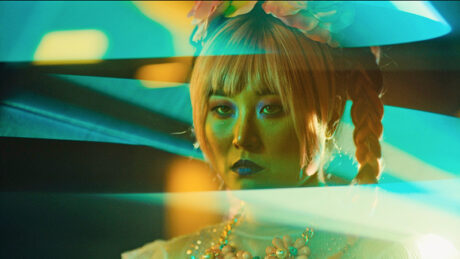
30 Years of Lasers, Lighting and Special Effects
Production Design International, Inc. celebrates 30 years in business this year. Founded in 1994 by Lighting and Laser Designer, Howard Ungerleider and Pyrotechnician, Brian Beggs, the Toronto, Canada-based Production Design International (PDI) is celebrating 30 years of cutting-edge work and industry leading innovation. PDI is a full-service production company specializing in custom laser, lighting, and special effects design, as well as special effects and production direction for concerts, events, and related projects. In addition to its wide array of concert work, PDI’s portfolio includes corporate and special events, sports facilities, film, television, and music videos, as well as nightclubs and bars, restaurants, themed environments, cruise ships, and retail.
PDI is well known for its longstanding relationships with bands like Rush for over 20 years, and TOOL, who they’ve supported with laser show effects, experienced programmers, and designers since 2006. The company’s list of shows, tours and festival credits is impressive with Foo Fighters, Kid Rock, Black Sabbath, Deep Purple, Foreigner, Bon Jovi, Britney Spears, Carrie Underwood, Veld, EDC, Escapade, and more. In terms of PDI’s corporate clients, they’ve worked with HP, Inc., General Motors, Ford, Infiniti, Kia, and others. Movie and TV projects include the Starz series American Gods and the film Kin. On this milestone occasion PDI Director Howard Ungerleider and PDI President Brian Beggs spoke with PLSN to discuss their history, standout projects the company has supported, and reflect on reaching 30 years in business. They also noted that PDI shows no signs of slowing down as they look forward to the future.
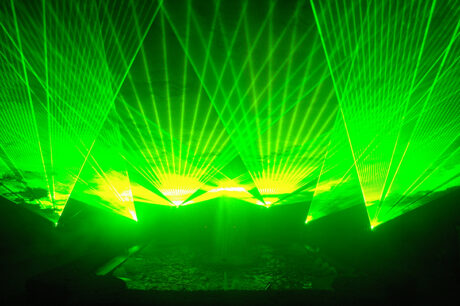
While better known for his own personal credit of over 40 years designing and directing lighting for Rush, Ungerleider joined up with Beggs, who specialized in pyrotechnics and special effects as a licensed pyrotechnician, along with a third partner formed Production Design International, Inc. in 1994. “When the three of us got together and formed PDI,” says Ungerleider, “my concept was a collaboration to bring higher quality special effects and lighting to our clients, and to be a custom house for lasers, lightings, and special effects.”
Beggs came from a musical background and became a pyrotechnician along the way. “My background was music itself as a bass guitar player and then followed along with pyrotechnics. I had come off the road one year and spoke with a friend of mine that was in the business and knew Howard. We decided that we were going to start a company that didn’t just focus on pyrotechnics but focused on other special effects and specialty lighting. That was in 1994. Howard and our other partner were at LDI as well as working on building a system that I had sold to a giant facility up here in Toronto. Howard said he’d be very interested in being part of the company, which was perfect. That’s how we started.”
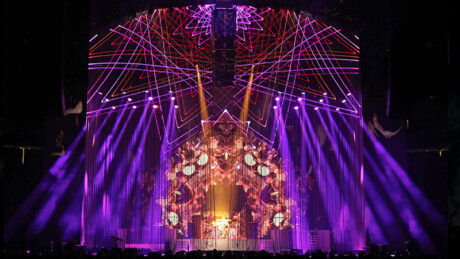
The Biggest Small Company
As with most companies, that’s the way they started off, and over the years PDI morphed into “the biggest small company,” Ungerleider comments. “People are amazed at what we do because we’re under the radar, yet we get heavy-duty, high-profile clients. I know a lot of that has to do with my years as Rush’s Lighting Designer and Director, as well as my work with lasers. Brian is a licensed pyrotechnician, so we had to figure out a way to basically join the two of us together after we released our third partner. We moved the company forward in a really, really positive direction.”
In terms of shared duties, Beggs handles the business and the finances, and “he also handles all the sports activities that we do,” says Ungerleider. “Then I handle some of the business development and the creative on the laser front for the artists that we represent. So, a lot of the times I will get involved with that aspect of it and sometimes not at all.” Beggs talks about the organic growth of PDI. “Howard was very deeply involved in rock ‘n’ roll touring before we started PDI, so it lent itself to our initial growth. We then expanded our offerings by adding pyrotechnics, lasers, and special effects.”
When PDI first started out, they had a large number of full-time employees, which has shifted over the years to more freelancers. “Covid erased a lot of that, unfortunately,” comments Ungerleider, “but all the people that we do hire have very creative backgrounds. So much so, that we could really trust them in creating a show themselves. I oversee some of the shows, but for me, I’m a believer in letting our people have their creative freedom. I loved having the creative freedom that I had with Rush for their whole run. Both Brian and I like our team to have their own creative freedom. It works for us, and we have a lot of freelance people we can draw on; I’d say six to ten people that we regularly call on and we have a good capability and can do multiple tours at the same time. The company has really morphed into something that’s kind of awesome because for a lot of our systems, we actually custom-design specific effects that run of the mill systems can’t do.”
One of the things that sets PDI apart from many production companies, is that they pull from older technologies and pair them with new products and tools to create custom, one-of-a-kind effects that bring a fresh design perspective to their clients and projects. “When you take the old and the new, and you mix it, you get something fresh and new,” explains Ungerleider. “A lot of the newer people out there don’t know the older technologies.” Beggs interjects, “That’s a bit of our secret sauce.” Ungerleider continues, “Yes, it’s our secret sauce, so we can make things happen that people go, ‘Wow, how did you do that?’ Of course, we won’t tell them, but it’s new to them, and it sets our shows apart from the ordinary.”
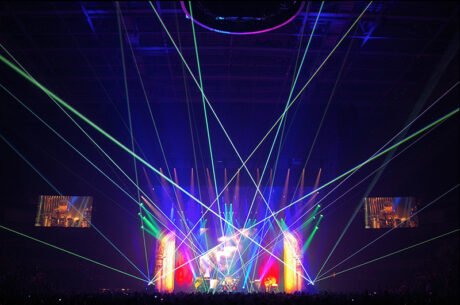
Safety First
Working in the special effects field, especially with lasers and pyro, safety is always top of mind for the PDI team. “We are licensed with every federal organization there is in the United States,” explains Ungerleider. “We follow the guidelines for Europe as well. I mean, we’ve been around for so many years and we have licenses for audience scanning.” Beggs also points out that PDI have “variance licenses to operate as well as a manufacturer. We have also done some manufacturing of our secret inventions that we put out on tours. We follow all the guidelines that the United States has because there’s really no legislation and guidelines in Canada to follow, so we make sure we just follow the United States guidelines for all our shows in North America. Europe has different guidelines, but being an international company, we follow all their guidelines as well.”
Beggs’ focus is more on sporting events, which has become a large portion of the work that PDI handles these days in addition to touring. “When you’re in an NBA or NHL environment, those organizations have their own requirements as well, and they’re very interested in what safety guidelines and laws are, as well as what they want to see in place. They like to have a lot of signage about the use of effects. Also, we use E-Stops for all our laser projectors, so in the event that somebody has gone into an area that there may be laser radiation going into, it’s as simple as a push of a button. A lot of times the fire marshals will want to have access to that, so we create those kinds of situations where some of of authority, like a fire marshal or a laser operator, can terminate the show with a simple push of a button for safety concerns.”
For all the tours, events, and projects that PDI supports they have Laser Safety Officers that travel with the tour. “Our Laser Safety Officers are trained and regulated. We go through inspections while we’re out there in various cities. Some of our people have their license for the state of New York. Once they go through rigorous testing and follow the guidelines, the inspections go very smoothly.”

Range of Markets
In addition to concert touring and sporting events, PDI also handles a range of markets and customers. “In addition to the big events and tours, we will also do smaller projects,” says Beggs, “like birthday parties. The equipment is not small, and the price range isn’t small. We will support birthday parties, graduations, and small bar venues all the way up to the biggest stadium tours in the world.” Ungerleider adds that PDI also “does a lot of corporate events. We’ve worked with the likes of Hewlett Packard, where we were in a dome at Coachella with them. We did the domes at Coachella twice and created a laser interface so that everyone could come in and use Hewlett Packard computers and run the lasers to a DJ that was spinning music. We like projects along those lines. We provided the lighting design and system for The Spirit of York Distillery in Toronto. We do theater, we just finished doing a run with the Rock of Ages tour that was been here for a few months. We do a lot of work with motion pictures and television, which we’re all over as well. We have worked on the productions of Kin and American Gods. In terms of concert touring, we have a longstanding relationship with Tool [See the cover story in the Feb. 2024 issue of PLSN] and recently provided support to the Foo Fighters. The work we do is far reaching, but it’s really under the radar kind of stuff, and that’s what we’re about here at PDI.”
As Beggs mentioned earlier, sports have been a strong and growing market for PDI. “Early on with PDI we did the NHL All Star Game in Toronto in 2000. “That was pivotal for us as far as the sporting work goes, because after that I started doing installations in some of the bigger venues in Canada,” he explains. Then most notably, I did the installation of an entire laser rig for the Cleveland Cavaliers last year. That was through a great friend, and business partner of ours, Eric Wade, from Crossfade Design.”
In terms of a milestone project that was key to building PDI over the years, Ungerleider quickly comments, “the General Motors auto show in Toronto. We did a 14-year run where I redesigned the lighting for the annual GM auto show in Toronto. We gave them a new concept of gridding the whole exhibit with a lighting truss and shutting off the lights in the building. At what used to be the SkyDome and is now the Rogers Centre in Toronto and it was also at the Toronto Convention Center during our years with GM. My concept to sell it to them years ago, was you used to walk around for five or six hours under mercury vapor lights, and you’d get a headache because that’s too much exposure to the discharge lights. I told them we could make the cars shine but leave the aisles for the attendees in a 3,000K environment so they’re comfortable. They don’t feel that they are on display as well as the cars. They liked the concept, even with a little resistance in the beginning. Once we put it together and showed them what it looked like, they were quite happy. That was certainly the changing point for PDI.”
Beggs picks up the thread, saying, “The Rogers Centre is a massive, massive place with the roof at 200’ plus, so Howard brought a whole grid in and just made it a lot more intimate for the whole car show. That was a new concept back. Instead of having sticks and individual trusses and lights for the different car companies, Howard had the foresight to bring the whole ceiling in, which eliminated a lot of ground supported trussing. This was on the lighting side but was one of the pivotal points for our company.”
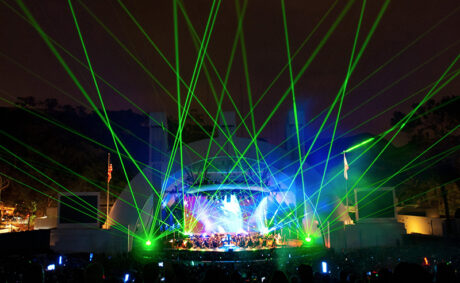
A Personal Touch
Both Beggs and Ungerleider have worked hard to keep PDI working on a wide range of products yet keeping the company from becoming oversaturated with work. “I think that a company can be personable. It can be a niche boutique, and it can also provide as much as someone needs without being oversaturated,” Beggs says. “A giant company sometimes loses touch with that personability. ‘The show just goes out the door and whatever is on it is fine.’ That will never happen with us. Again, Howard as the designer still has that secret sauce that we want to put into all the work that we do. It still is personal to us, and it shows in the products of the work that we do.”
Ungerleider agrees and adds, “We’re very proud of what we’re accomplishing here. In terms of the secret sauce, when you get out there, you want to make each individual project its own project. You don’t want to create a cookie cutter. That’s the one thing that we stay away from—cookie cutter looks. We do not want one act to look like another, and we’re very, very serious about that. We will go out of our way to make things stand out. I mean, it’ll create more work, but at the end of the day, it’ll be a much better product. As a designer, I know what I look for. I know how to make something look spectacular, and I like to work in conjunction with the other designers out there, feeding off each other. I get a lot of respect for what I’ve done from other designers, and there’s some great designers out there like Dan Hadley, Mark Jacobson, and Breck Haggerty. All those guys are incredible. I have respect for them as a designer.”
He also has respect for younger designers coming up and is happy to offer mentoring to them. “There are some great young designers absolutely, who I love, and I’ll support,” says Ungerleider. “Sometimes people look at it as a competitive element, but I look at it as a collaboration. I’m not there to take anyone’s gig away. I’m there to help their gig look better, and I think they understand that. If you deal with an entourage situation and you’re personable, you’re a likable person, it just makes it go smoothly. There’s a give and take and it helps inform you and your work. I can bring in some new ideas and they can bring in ideas, and sometimes we come up with a different design approach, a different concept. I don’t like to get people’s backs up. Some say, ‘this guy’s a designer. We don’t want him here; it’ll be a conflict.’ With me, it’s never a conflict. I’m open to listening to everyone’s ideas. As far as I’m concerned, if I could help make something better by making suggestions, I would. Then everyone’s a winner.”
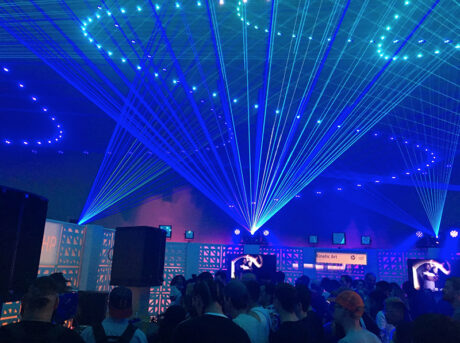
Looking to the Future
Beggs, Ungerleider, and the PDI team are not resting on their laurels. They have a lot of irons in the fire, with a number of projects happening. The Tool tour is back out on the road for its next leg with Laser Designer/Programmer/Operator Scott Wilson from PDI heading up the laser design and operation on tour. “I’m working with Lawrence Gowan, the lead singer for Styx on a solo project in Canada,” says Ungerleider. “I’ve worked with him for years. We just did a show with him at Massey Hall in Toronto that was a huge success. I’m looking at the possibility of doing something a large planetarium coming up. I’m probably working on 10 different projects at once.”
Ungerleider strongly feels that with the diversity of the company, “the different places we can go; it’s limitless. Whatever people out there need we’re pretty limitless. We have lots of ideas to go with their ideas and make a better show. We’re happy to consult and guide; maybe someone who has never used a laser before, or they’re kind of concerned with their lighting overwhelming video or video overwhelming the lighting. We’re happy to be there as a consultant for everything with a design eye.”
When you look at the range of bands, tours, events, and projects that PDI has handled over its three decades in business, it’s impressive. Neither of the two partners in PDI see themselves slowing down, in fact they have a lot of plans for the future. Beggs comments, “We really love what we do. Howard and I were just talking about it recently and we both said that we don’t want to retire because there’s nothing else to do!” We at PLSN are happy to highlight the great work of PDI and we raise our glasses to toast Beggs, Ungerleider, and the whole PDI team on its 30-year anniversary and can’t wait to see what comes next for this dynamic and creative company.
